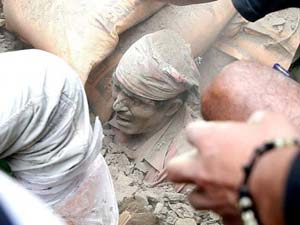 Rescuers, some wearing face masks to keep out the dust, scrambled over mounds of splintered timber and broken bricks in the hope of finding survivors here today.
Rescuers, some wearing face masks to keep out the dust, scrambled over mounds of splintered timber and broken bricks in the hope of finding survivors here today.
The 7.9 magnitude quake struck at midday on Saturday at a busy time of year for the tourism reliant country’s trekking and climbing season, with an estimated 300,000 foreign tourists in the country, home to many World Heritage sites.
Nepalese Rescuers dug with their bare hands and bodies piled up in Nepal today after an earthquake devastated the heavily crowded Kathmandu Valley, killing more than 2,000 people,figure that could increase.
A big aftershock between Kathmandu and Everest unleashed more avalanches in the Himalayas. In the capital, hospital workers stretchered patients out onto the street to treat them as it was too dangerous to keep them indoors.
The tremor, measured at 6.7, was the most powerful since Saturday’s 7.9 quake, itself the strongest since Nepal’s worst earthquake disaster of 1934 that killed 8,500 people.
The aftershock rocked buildings in the Indian capital New Delhi and halted the city metro.
In Everest’s worst disaster, the bodies of 17 climbers were recovered from the mountain today after being caught in avalanches. A plane carrying the first 15 injured climbers landed in Kathmandu at around noon local time.
With Nepal’s government overwhelmed by the scale of the disaster, India flew in medical supplies and relief crews, while China sent in a 60-strong emergency team.
Relief agencies said hospitals in the Kathmandu Valley were overflowing and running out of medical supplies.
Among the capital’s landmarks destroyed in the earthquake was the 60-metre (200-foot) Dharahara Tower, built in 1832 for the queen of Nepal, with a viewing balcony that had been open to visitors for the last 10 years.
Some buildings in Kathmandu toppled like houses of cards, others leaned at precarious angles, and partial collapses exposed living rooms and furniture in place and belongings stacked on shelves.
Thousands of people spent the night outside in chilly temperatures and patchy rain, too afraid to return to their damaged homes.
On Sunday, survivors wandered the streets clutching bed rolls and blankets, while others sat in the street cradling their children, surrounded by a few plastic bags of belongings.
More than 700 were killed in the capital, a city of about 1 million people where many homes are old, poorly built and packed close together.
The main earthquake, centred 50 miles (80 km) east of the second city, Pokhara, was all the more destructive for being shallow.
(Prensa Latina)